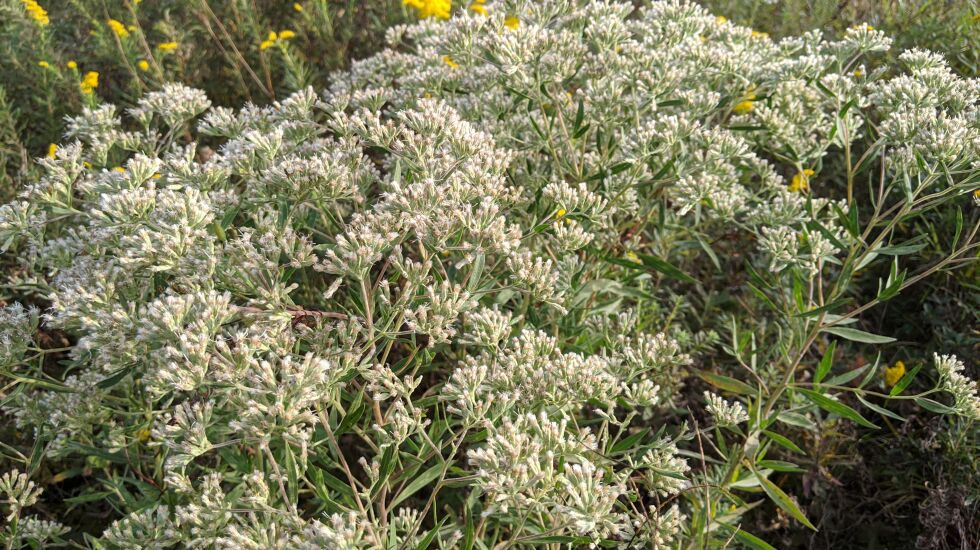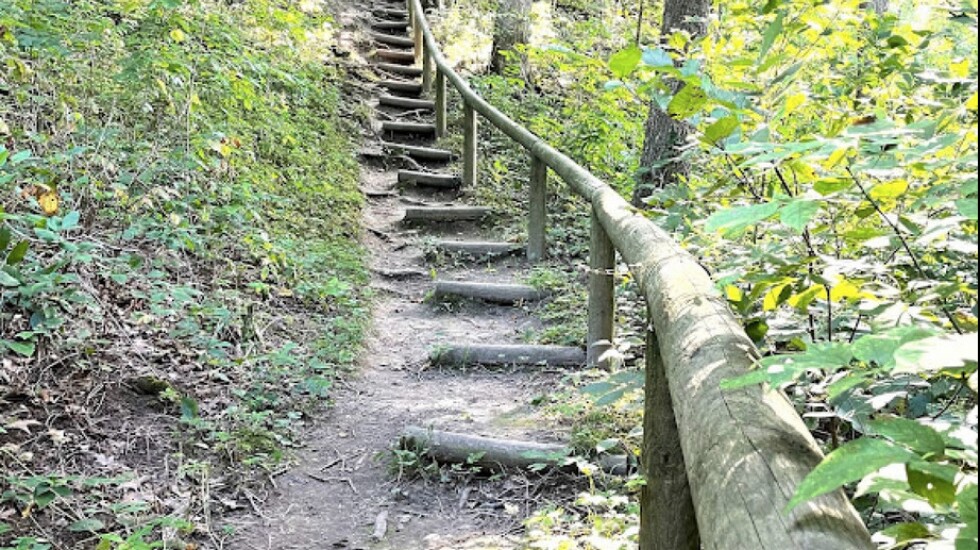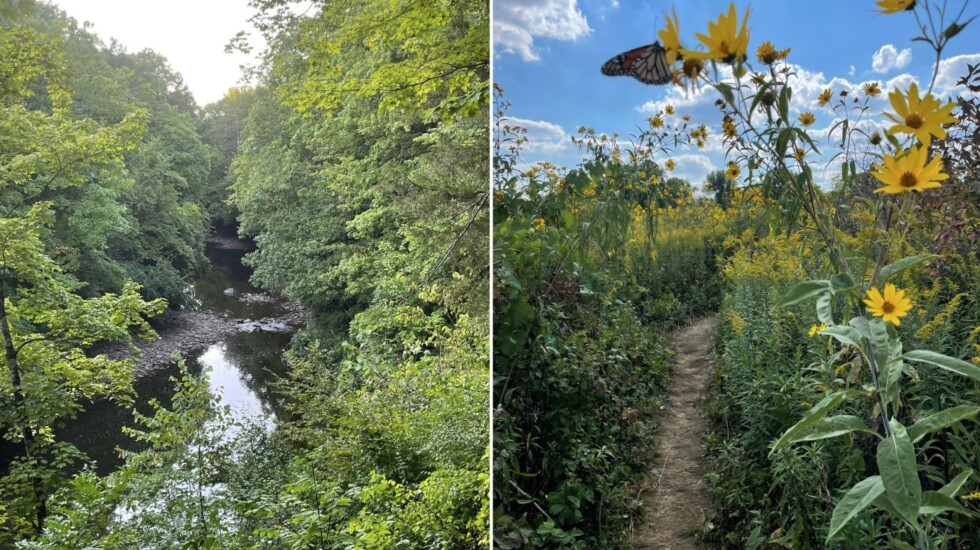
It’s not “purple mountains majesty” for hiking, Jason King knows. But Illinois, Indiana and southern Wisconsin offer trails that are free, close, not congested, and they offer a solace and beauty all their own.
“I love Illinois,” says King, who teaches geography at Moraine Valley Community College in Palos Hills. “I’ve lived here all my life. If you like simplicity, if you like the feel of the wind blowing through the trees … there’s no place better.”
One of his favorite solo hikes to “get the world behind me” is near Gary, in the little-used western part of Indiana Dunes National Park. The Paul H. Douglas center is closed for now, but the namesake trail winds through Miller Woods and across the Grand Calumet River. It was named for the late U.S. senator from Illinois, who helped make the Dunes a national park. It’s a moderately challenging three and a half miles out and back, partly through sand dunes, so it’s a workout.
“It’s a truly unique trail,” King says. “I can’t think of another where, in a couple of miles, you’ll see a forest, you’ll see a marsh, you’ll see a unique biome called a black oak savannah, then the dunes, and finally you’re at the shore of Lake Michigan.”
There are many such gems within three hours of Chicago that aren’t as urban as the North Branch River Trail or as crowded as Starved Rock State Park in Utica. The joys of fall hiking include leaves changing colors, fewer mosquitos and ticks and cooler weather.
The list that follows of hiking trails near Chicago is based on in-person exploration the past three years, online sources and conservation groups like Openlands. Check the websites for access information and hours. Remember: Dogs aren’t allowed in any Illinois nature preserve.
South
King takes less ambitious hikers — his 6- and 8-year-old kids — to a trail that starts at Little Red Schoolhouse Nature Center in Willow Springs. Besides indoor exhibits, there is a primitive outdoor playground and plenty of programs. Three natural surface trails of varying lengths total two and a half miles through black oak and white oak forests past a slough full of aquatic life that’s flourished from three decades of restoration.
It’s one of several starting points for the extensive, much-loved and occasionally rugged 42-mile Palos trail system that is dear to serious hikers. The yellow trail connects near the schoolhouse. Many other access points are listed on maps that rate skill levels from easy to very difficult. Watch out for mountain bikers.

The trails contain a surprising amount of elevation, given that much of Illinois was bulldozed flat by mile-high glaciers during a series of ice ages that ended about 10,000 years ago.
But the glaciers left moraines and other features that the melting ice and water later cut through, creating valleys and gorges. Walking up and down as much as 200 feet on these trails, a visitor is traversing sand and rock debris carried and deposited by a glacier, then dug out by rushing ice and water. Some large chunks of ice broke off, sunk and created lakes and marsh.
Next door to Palos and just south of the Calumet-Saganashkee Channel, which was dredged to help reverse the Chicago River, is the largest roadless area — and most remote place — in Cook County: Cap Sauers Holding, a forested, certified nature preserve within the Sag Valley Trail System.
The seven-mile yellow loop winds through wooded bluffs and ravines, wetlands and prairie openings. Look for a very narrow, less traveled, hikers-only loop that branches north over an esker — a rare ice age feature.
Southwest
McKinley Woods in Channahon hugs the Des Plaines River in Will County as it carries water from the Chicago River to the Illinois River. Frederick’s Grove, a former Civilian Conservation Corps camp, offers two miles of dirt trails to a 500-acre chinquapin and white oak grove. The one-hour drive in fall offers a chance to see white pelicans feeding along the river and gathering for migration.
The adjacent limestone Illinois and Michigan Canal State Trail follows the 1840s waterway for 61 miles.
Going to or from McKinley, you’ll pass near the Midewin National Tallgrass Prairie in Wilmington, a former Army ammunition plant on 20,000 acres that’s slowly being restored to native prairie with the help of volunteers and a bison herd.

Messenger Woods Nature Preserves — in Homer Glen — is a 400-acre protected preserve with a two-mile natural surface loop trail good for children.
Nearby in Park Forest is another nature preserve, Thorn Creek Woods Nature Preserve, managed by Will County. It’s filled with mature oak, hickory, basswood and sugar maple trees and has two miles of natural surface trails and a nature center.
West

A green heron stalks the far bank of Lee County’s Franklin Creek, where a grist mill once turned. The heron’s legs sink into the mud, and its crest rises and falls. The water’s edge riffles as minnows shoot toward the middle of the creek, away from the searching yellow eyes and long, sharp beak of the heron. Upstream, two ruby-throated hummingbirds feed on tall, waving sunflowers.
The five miles of trails at the 882-acre Franklin Creek State Natural Area near Dixon border the stream and take hikers up and down the steep, forested hills and gorges carved out of a moraine, exposing outcroppings of 500-million-year-old New Richmond sandstone — the oldest exposed rock in Illinois.
Start at Mill Springs Day Use Area to access the exceptional two-mile Pioneer Pass trail, where hikers will cross one of several bubbling clear springs emerging from the bedrock. The trail is a natural surface with steps and railings in places and is in average condition, which will make it a workout for older knees.
Having made the roughly two-hour trip west, it only makes sense to see the bison at Nachusa Grasslands, where the Nature Conservancy and its partners are restoring 4,000 acres of prairie. There are a few miles of trails through the prairie, including one that begins at a new outdoor visitors center. Off-trail hiking is encouraged.
A short distance farther west is the Rock River and the colorful sandstone cliffs of Castle Rock State Park.
Nearby, Lowden-Miller State Forest has 22 miles of hiking trails, and several short loop trails take hikers through White Pines State Park.
Near West
A ring of gray, denuded trees comes into view, standing sentinel over a low-lying sedge meadow. A woodpecker hammers one of the trees, sending a wooden echo across the bur oak savannah. Late-day sunlight filters through the leaves and lights up the goldenrod. Six bluejays in treetop branches make their “squeaky gate” calls.
This urban refuge, the 245-acre Salt Creek Woods Nature Preserve, is 10 miles west of Chicago and sports a lightly used trail in the middle of La Grange Park. Piles of invasive buckthorn and fire-scarred trees are reminders that Cook County is working with the Shedd Aquarium and volunteers to restore the area.
Hikers can start in several spots and walk the Salk Creek yellow trail for about two miles. The trail access points are away from the main parking lots. One point is near a picnic shelter at Bemis Woods. Another is off Mayfair Drive — park on Mayfair, and cross 31st Street at the stoplight to find the “Bob Mann” sign.

Hikers can combine the Salt Creek trail with a walk through a rare nature preserve at Wolf Road Prairie, a high-quality remnant of a pre-settlement Illinois tallgrass prairie. Two hundred years ago — about the age of one of the bur oaks here — this was part of a landscape of 22 million prairie acres dotted with small groves. Right before the Great Depression, this property in Westchester was slated to become a subdivision. Now, only the concrete sidewalks remain among the acres of tall sawtooth sunflowers and other native plants tended by volunteers. Less than 1% of Illinois prairie remains.
It’s a five-minute walk from Wolf Road Prairie at its 31st Street entrance (next to a Shell station) south to Salt Creek trail on Wolf Road. Explorers can cover a mile out and back on the restored prairie and add another two miles on Salt Creek’s footpath.
Or visitors can park on Constitution Avenue, south of Cermak Road, near the historic Franzosenbusch schoolhouse and home built in 1852 by German immigrants (open Sundays 3 p.m. to 5 p.m.).
In DuPage County, hikers can enjoy a series of easy, crushed limestone trails layered throughout several well-managed preserves showcasing a variety of landscapes. Starting at the east end at Danada Forest Preserve, about 19 miles of trails connect to, in order: Herrick Lake Forest Preserve, St. James Farm, Warrenville Grove and the county’s crown jewel, Blackwell Forest Preserve.
The 60-mile limestone Illinois Prairie Path also runs through at St. James Farm.
If you have young kids, you can try the short loop at nearby Lyman Woods, another certified nature preserve.
Northwest
In the northwest corner of Illinois, and into Wisconsin, is the unglaciated Driftless Area, a stark and striking hilly landscape, cut with valleys large and small.
One of the most gorgeous sites in the state is the 1,900-acre Apple River Canyon State Park, about 2.5 hours from Chicago, with several miles of trails through limestone bluffs, deep ravines, springs and streams.
North
Farther north, in Wisconsin, is Devil’s Lake State Park, about a three-hour drive from Chicago, which has 30 miles of hiking trails and 500-foot quartzite bluffs that overlook a 360-acre lake.
Glacial Park Conservation Area, about 90 minutes northwest of Chicago, is McHenry County’s most popular outdoor destination due to the diversity of its 3,400 acres containing savannah, prairie, bog, kettle marsh and the prized Nippersink Creek.
Several concentric loop trails, the longest three miles, total five miles. A 26-mile regional Prairie Trail cuts through the area going south, and north (unpaved) to the Wisconsin border.
For another stop on the way to Glacial Park, the 2,200-acre Moraine Hills State Park is dominated by lakes and wetlands criss-crossed by 10 miles of trails, mostly crushed limestone. A longer trip into Wisconsin, about a two-hour drive, will deliver adventurers to the southern unit of the Kettle Moraine State Forest — a supersized Moraine Hills with 10 times the acreage, 100 miles of trails and access to a much longer Ice Age National Scenic footpath of 1,000 miles.







